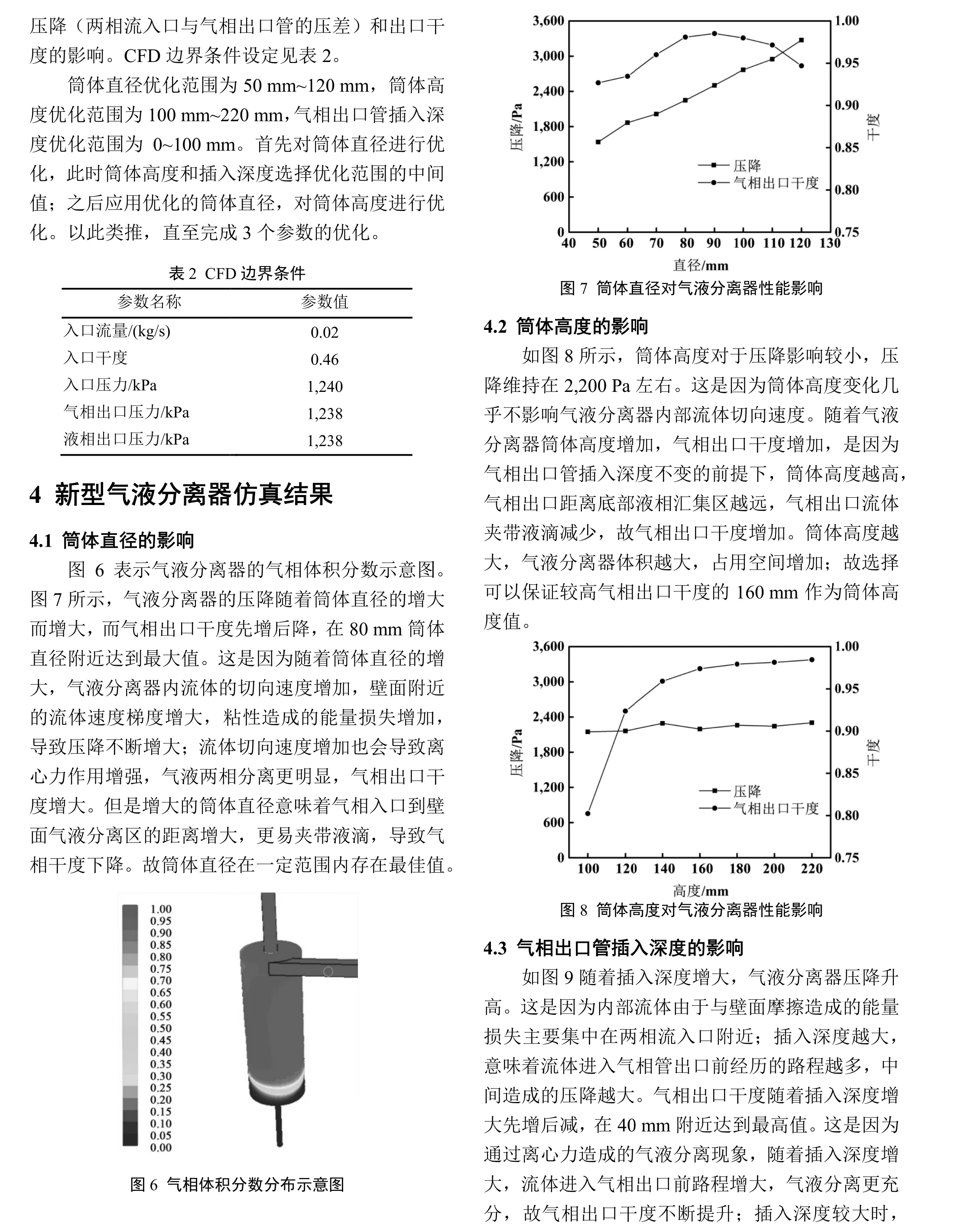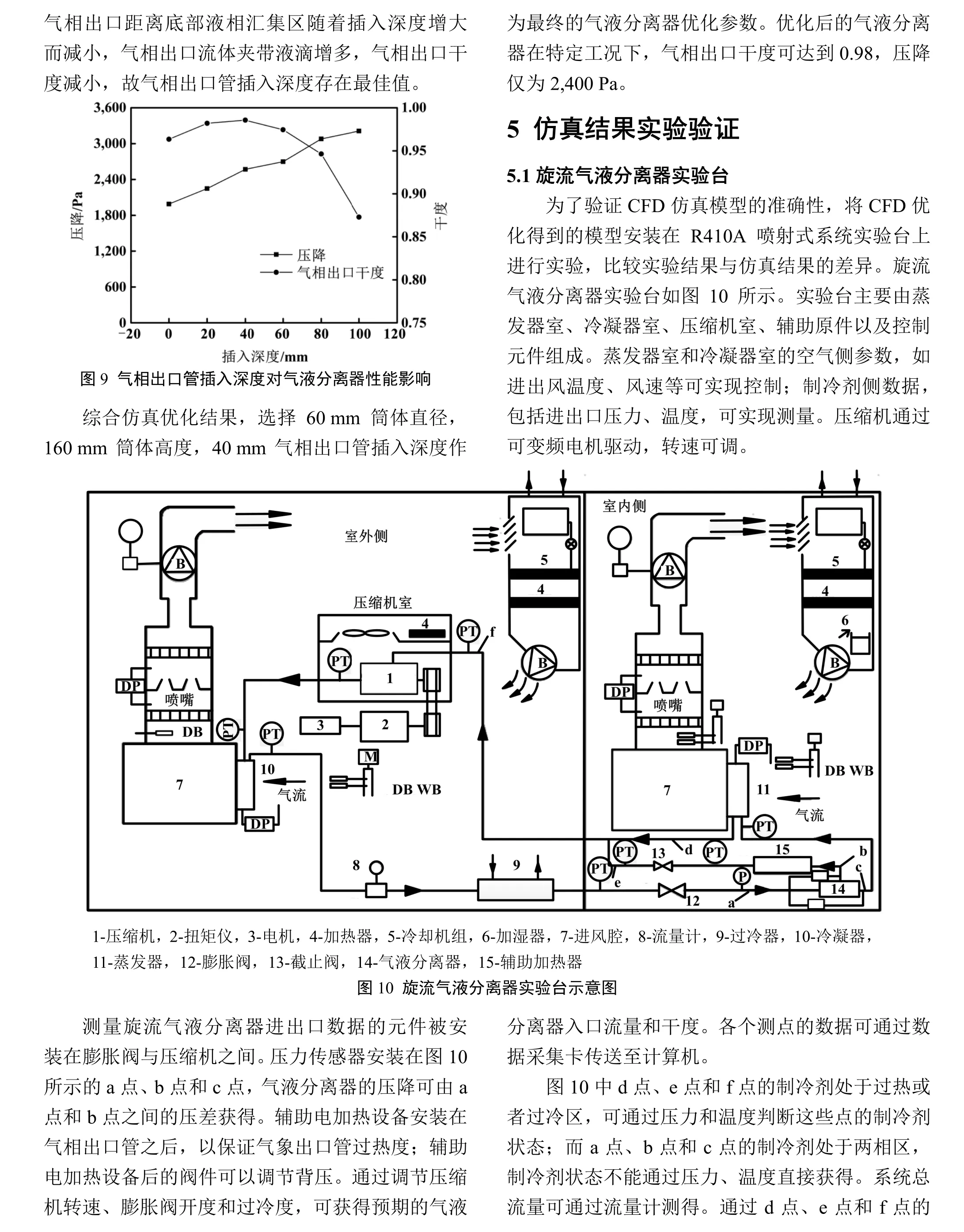喷射式制冷系统新型旋流气液分离器的设计与优化
胡记超,王丹东,王雨风,陈亮,陈江平∗,2
(1-上海交通大学机械与动力工程学院,上海 200240;2-上海市高效冷却系统工程技术中心,上海 200240)
0 引言
使用喷射器代替传统制冷系统中的膨胀阀,可以有效回收节流损失,提升系统性能[1-3]。气液分离器作为喷射式制冷系统的一个关键部件,其分离效率和压降特性对系统性能有着很大影响。
喷射式制冷循环的工作循环为:冷凝器出口制冷剂进入喷射器的喷嘴内增速降压,引射蒸发器出口的气态制冷剂,混合后进入扩压段减速升压;之后制冷剂进入气液分离器,气液分离后气体进入压缩机,液体节流后进入蒸发器,蒸发后再作为引射流体进入喷射器[4-9]。R410A喷射式制冷循环的流程[10]和lgp-h图,如图1所示。气液分离器的分离效率一方面会影响进入蒸发器的制冷剂干度,进而影响制冷量[11-13];同时会影响进入压缩机的制冷剂干度[14-16],进而影响压缩机功率。





[1]DISAWAS S,WONGWISES S. Experimental investigation onthe performanceof the refrigeration cycle using a two-phaseejector as an expansion device[J].International Journal of Refrigeration, 2004, 27:587-594.
[2]ELBEL S, HRNJAK P. Experimental validation of a prototype ejector designed to reduce throttling losses encountered in transcritical R744 system operation[J].International Journal of Refrigeration, 2008, 31(3):411-422.
[3]LEE J S, KIM M S, KIM M S. Experimental study on theimprovement of CO2air conditioning system performanceusing an ejector[J]. International Journal of Refrigeration, 2011, 34: 1614-1625.
[4]NAKAGAWA M, MARASIGAN A R, MATSUKAWA T. Experimental analysis on the effect of internal heat exchanger in transcritical CO2refrigeration cycle with two-phase ejector[J]. International Journal of Refrigeration, 2011, 34(7): 1577-1586.
[5]TAKEUCHI H, NISHIJIMA H, IKEMOTO T. World's First High Efficiency Refrigeration Cycle with Two-Phase Ejector: “Ejector Cycle”[C]// SAE 2004 World Congress and Exhibition, 2004.
[6]TUO H, BIELSKUS A, HRNJAK P. Effect of flash gas bypass on the performance of R134a mobile air-conditioning system with microchannel evaporator[J].SAE International Journal of Materials and Manufacturing, 2011, 4(1): 231-239.
[7]何曙, 李勇, 王如竹. 喷射器理论研究进展[J]. 低温与超导, 2008, 36(11): 37-39.
[8]吴迎文, 梁祥飞, 郑波, 等. 单相喷射器内二维流场数值模拟与结构设计[J]. 制冷技术, 2013, 33(3): 52-55.
[9]熊杰, 王如竹, EIKEVIK T M. 基于单相R744喷射器系统的引射比计算模型及其实验验证[J]. 制冷技术,2015, 35(2): 1-7.
[10]郭兴龙, 宋新南, 胡自成. 膨胀机与喷射器跨临界二氧化碳循环比较研究[J]. 制冷技术, 2012, 32(2): 57-60.
[11]池本彻, 武内裕嗣, 西山鸟, 等. 新型喷射循环(Eject Cycle)车用冷冻机的开发[J]. 制冷技术, 2008, 28(1):19-26.
[12]山田悦久, 西嶋春幸, 松井秀也, 等. 小型货车用喷射式冷冻机[J]. 制冷技术, 2010, 30(2): 35-39.
[13]戚大威, 柳建华, 张良, 等. 蒸汽压缩/喷射制冷系统喷射器设计及节能分析[J]. 制冷学报, 2014, 35(1):103-108.
[14]傅丰, 赵在三, 郁鸿凌. 气液两相流体干度测量的研究与发展[J]. 动力工程, 1991, 11(3): 51-59.
[15]张海鹏, 龚圣捷, 赵彦青, 等. 混合法测量蒸汽干度[J].计量技术, 2004(2): 6-7.
[16]杨方, 韩玉生. 测量和控制蒸汽干度的方法[J]. 国外石油机械, 1994, 5(1): 63-67.
[17]吴腾飞, 臧润清, 刘江彬. 再循环重力供液系统气液分离理论分析[J]. 制冷技术, 2013, 33(3): 39-41.
[18]周华, 夏南. 气分离器内气液两相流的数值模拟[J].计算力学学报, 2006, 23(6): 766-771.
[19]MOVAFAGHIAN S, JAUA-MARTURET J A, MOHAN R S, et al. The effects of geometry, fluid properties and pressure on the hydrodynamics of gas-liquid cylindrical cyclone separators[J]. International Journal of Multiphase Flow, 2000, 26(6): 999-1018.
[20]MA L, INGHAM D B, WEN X. Numerical modelling of the fluid and particle penetration through small sampling cyclones[J]. Journal of Aerosol Science, 2000, 31(9):1097-1119.
[21]YANG I H, SHIN C B, KIM T H, et al. A three dimensional simulation of a hydrocyclone for the sludge separation water purifying plants and comparison with experimental data[J]. Minerals Engineering, 2004, 17:637-641.
[22]吴春笃, 张伟, 黄勇强, 等. 新型旋流分离器内固液两相流的数值模拟[J]. 农业工程学报, 2006, 22(2):98-102.

